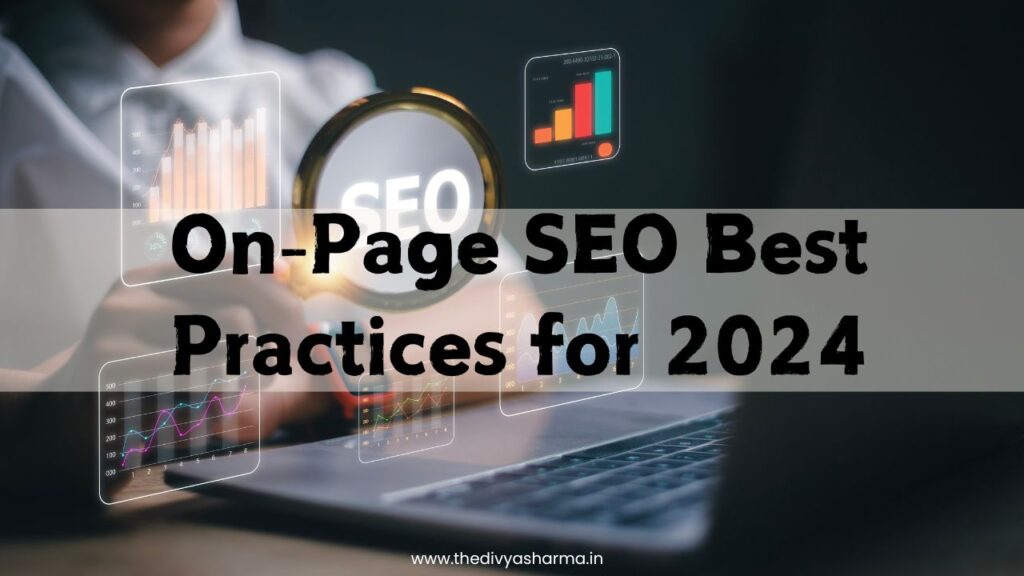
On-Page SEO Best Practices for 2024
Table of Content
On-Page SEO Best Practices for 2024
As search engine algorithms continue to evolve, staying updated with the latest on-page SEO best practices is crucial for maintaining and improving your website’s rankings. On-page SEO involves optimizing individual web pages to rank higher and earn more relevant traffic in search engines. Here are the best practices for on-page SEO in 2024 to help you stay ahead of the competition.

1. Optimize Your Title Tags
Title tags are one of the most important on-page SEO elements. They are the first thing users see in the search engine results pages (SERPs) and play a crucial role in your website’s click-through rate (CTR).
- Include Your Primary Keyword: Make sure your primary keyword is at the beginning of your title tag.
- Keep It Under 60 Characters: Search engines typically display the first 60 characters of a title tag. Keep it concise and to the point.
- Make It Compelling: Write a title that encourages users to click through to your site.
2. Write Engaging Meta Descriptions
Meta descriptions provide a summary of your page’s content. While they don’t directly impact rankings, they can influence CTR, which is a ranking factor.
- Include Your Primary Keyword: Use your primary keyword in the meta description naturally.
- Keep It Under 160 Characters: Aim for a concise, informative description that entices users to click.
- Include a Call-to-Action: Encourage users to visit your site with a compelling call-to-action.
3. Use Header Tags Appropriately
Header tags (H1, H2, H3, etc.) help structure your content and make it easier for search engines to understand.
- H1 Tag: Use one H1 tag per page, and make sure it includes your primary keyword.
- H2 and H3 Tags: Use H2 and H3 tags to break up your content into sections. Include secondary keywords where relevant.
- Keep It Organized: Ensure your headers follow a logical structure that makes your content easy to read.
4. Optimize Your Content
Content is king when it comes to on-page SEO. High-quality, relevant content can significantly improve your rankings.
- Primary and Secondary Keywords: Naturally incorporate your primary and secondary keywords throughout your content.
- Content Length: Aim for comprehensive content that covers the topic thoroughly. Longer content often ranks better, but make sure it’s valuable and not just filler.
- Readability: Use short paragraphs, bullet points, and simple language to make your content easy to read.
- Multimedia: Incorporate images, videos, and infographics to enhance user engagement.
5. Optimize Images
Images can enhance the user experience, but they can also slow down your page if not optimized properly.
- Use Descriptive File Names: Rename image files to describe the content, using hyphens to separate words.
- Alt Text: Include descriptive alt text for each image, incorporating keywords where relevant.
- Compress Images: Use tools to compress images without losing quality to improve page load speed.
6. Improve Page Load Speed
Page load speed is a critical ranking factor and directly affects user experience.
- Minimize HTTP Requests: Reduce the number of elements on your page to decrease load time.
- Enable Compression: Use Gzip to compress files and reduce the size of your HTML, CSS, and JavaScript files.
- Optimize Code: Minify CSS, JavaScript, and HTML to remove unnecessary characters and spaces.
- Leverage Browser Caching: Set up caching to store static files, so they don’t have to be reloaded every time a user visits your page.
7. Ensure Mobile-Friendliness
With the increasing number of mobile users, ensuring your site is mobile-friendly is crucial.
- Responsive Design: Use a responsive design that adapts to different screen sizes.
- Mobile Usability: Ensure buttons and links are easily clickable, and text is readable without zooming.
- Mobile Page Speed: Optimize your mobile page speed using tools like Google’s Mobile-Friendly Test.
8. Use Internal Linking
Internal links help search engines understand the structure of your website and establish a hierarchy.
- Relevant Anchor Text: Use descriptive, keyword-rich anchor text for your internal links.
- Link to Important Pages: Make sure to link to important pages to give them more authority.
- Avoid Overlinking: Don’t overdo it; keep internal links relevant and useful to the reader.
9. Implement Schema Markup
Schema markup helps search engines understand your content better and can enhance your search listings with rich snippets.
- Structured Data: Use structured data to provide additional information about your content.
- Schema Types: Implement relevant schema types, such as articles, products, reviews, and events.
- Test and Validate: Use Google’s Structured Data Testing Tool to ensure your schema markup is correctly implemented.
10. Focus on User Experience (UX)
User experience is becoming increasingly important for SEO. A positive UX can lead to higher engagement and lower bounce rates.
- Clear Navigation: Ensure your site is easy to navigate with a clear menu structure.
- Engaging Design: Use a clean, engaging design that keeps users interested.
- Interactive Elements: Incorporate interactive elements like quizzes, surveys, and forms to enhance engagement.
Conclusion
On-page SEO is a fundamental aspect of digital marketing that can significantly impact your website’s performance in search engines. By following these best practices for 2024, you can ensure your website is optimized for both search engines and users, leading to higher rankings, increased traffic, and better overall performance. Start implementing these strategies today and stay ahead of the competition in the ever-evolving world of SEO.
Leave a Comment
“Thank you for taking the time to learn more about me. If you’re looking to enhance your digital presence and achieve your marketing goals, I would love to connect and discuss how I can help your business grow.”
